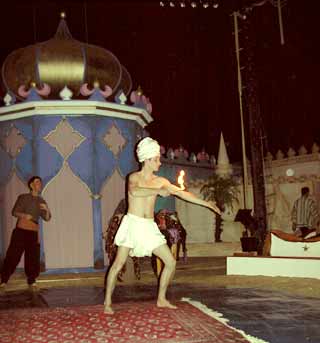Ami Ben Best

Memory, says Spectrum, is an elusive store of facts. This is a pretext for that
that any event that occurred in the distant past can sometimes have several versions,
as the number of people who watched it. Of course, we must not forget his creative role
of the imagination, especially when it comes to attempts to recreate stealthy events
especially.
This kind of creativity is indicated by a study conducted not long ago by a duo
British psychologists. As part of the study, the history of one of the charms was examined
The most well-known in the world is the so-called "Indian rope trick". since the century
The 19 were published in countless British and Indian press
Eyewitness accounts of people who claimed to have seen fakirs with their own eyes
who perform this mysterious and exotic trick. One of the problems that came back
And what changed in these testimonies was the existence of different versions as to the manner
Doing the trick. The study in question, ask to check this record number.
But first it is worth saying something about the magic itself.
According to the most common version, the fakir pulls a long rope from under his cloak
and throws it into the air. The rope does not fall to the ground but remains stable in shape
vertical, motionless. A small boy starts to climb it quickly, until he disappears
at the end The fakir climbs after him with a drawn knife, and immediately after
Several severed limbs fall to the ground. The Indian comes off the rope quickly
and collect the blood-drinking organs into a small bag. Some time later the boy
Appears safe and sound.
The researchers took the trouble and collected from the newspapers 22 rather individual testimonies of
this trick and put them in front of a bunch of magicians. The group was requested
Carefully examine the various descriptions, and classify facts that impressed them
More than any. For example, did the child just climb to the end of the rope? or "disappeared"
? , etc. When the psychologists later tested the magicians' conclusions
And compare them with the amount of time that passed from the moment the trick was played to the delivery
The report found that as more time passed since the event, the plot changed
To be more "impressive", or in other words, more exaggerated.
This count also has another aspect. The huge popularity of this trick
resulted in many generations of magicians attempting to perform it. As of today, all
The attempts failed, which strengthened the assumption among many that this is indeed the case
In a myth, or in a folkloristic legend that has no cover. But the whole thing
took a certain turn, precisely recently, when a pair of physicists,
British, of course, claimed that the first part of the trick could be... done.
How It Works ? Well, imagine for a moment that this is a long stick
vertically on your palm and you try to maintain this position while moving your palm
hand from side to side. This is not a big problem. At the beginning of the century it was discovered, based
on Newton's laws, because the upright position of a stick can be maintained, even when
Move the hand, or the base on which the stick rests, up and down. surplus
From this, if we move the base, fast enough, and at a short enough distance, we can,
According to the physicists, keep the stick, or several sticks that stand one
on the other, in a vertical position and in equilibrium. Since every rope is actually a connection
of total short and hard fibers (fibers compared to rods), here
the solution.
It is true that an extremely fast engine is needed, and it is true that fakirs, in the opinion of
Spectrum, don't like tricks, but theoretically at least it works.
Will the child disappear at the end? It's already a different story.
https://www.hayadan.org.il/BuildaGate4/general2/data_card.php?Cat=~~~334600413~~~101&SiteName=hayadan
